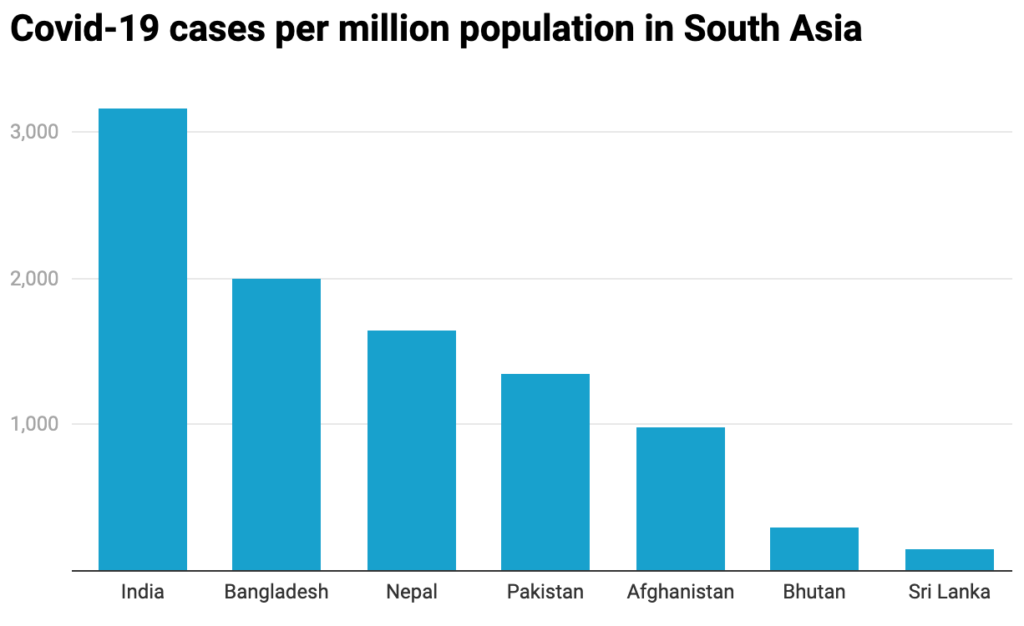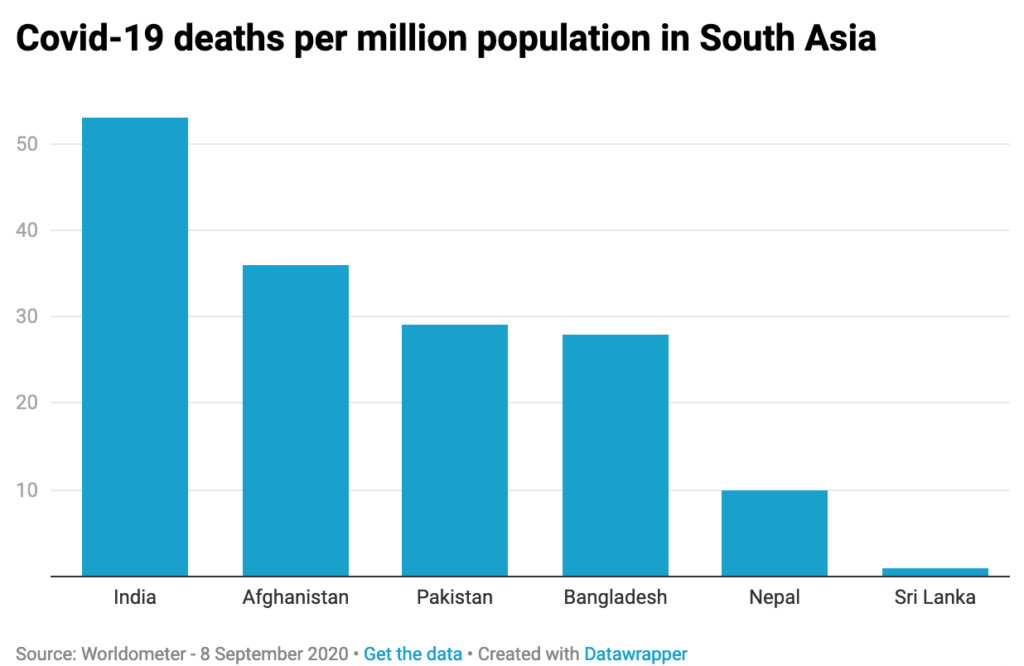Shoaib Daniyal
South Asia is the most densely populated part of the world and also one of the poorest. With very low standards of healthcare, the region was seen as very high risk for the Covid-19 pandemic.
Surprisingly, however, most countries have done well to contain the pandemic. With one exception: the largest country in the region, India.
ndia now has 4.4 million total cases – making it the country with the second highest number of cases. For the past week, India has also been clocking the highest number of new cases in the world.
With socio-economic conditions across South Asia being similar, how did India’s position diverge so sharply?
India’s lead
India outstrips other countries in the South Asia region, with a Covid-19 caseload that is 13 times that of Bangladesh and 15 times of Pakistan.
However, since India is also the largest country in the region, a better way to measure performance would be to look at per capita figures. Even there, however, the situation in India is worrying compared to the rest of South Asia.


With respect to total cases per million population, India is 1.6 times Bangladesh and 2.3 times Pakistan. In comparison to Sri Lanka – which has had remarkable success in controlling the disease – India’s cases per million population is as high as 21.5 times.
Matters remain much the same with deaths per million of population. India’s is nearly twice that of Bangladesh and Pakistan.
Even starker: cases in Bangladesh and Pakistan are on the downturn, while they are still rising rapidly in India.
In mid-June, for example, Pakistan hit nearly 7,000 new cases a day. That has crashed to 330 for September 8. In the same period, however, India shot up by 9 times, going from around 10,000 new cases a day in mid-June to nearly 90,000 new cases on September 8 –the highest in the world (by some distance).

Is India really doing so badly?
The first roadblock to any inter-country comparison is the question: is the data comparable at all? For example, cases tabulated are obviously a function of tests conducted. And on that, actually, India performs rather well with 3.6 and 2.9 times the number of tests per million population as Bangladesh and Pakistan, respectively.
To add to this is the fact that what every country counts as a positive case itself might be different, explains virologist Jacob John, a former professor at Christian Medical College, Vellore. “In India, we aggressively chased infections and tested even asymptomatic people,” said John. “But Pakistan would have mostly tested sick people. This would have inflated India’s numbers.”
Apart from issues with data comparability, Pakistan might also be helped by its demographics. India’s median age is 28.7 while Pakistan is younger at 22. Part of the difference for this mortality could come from demographics, given that Covid-19 mortality goes up sharply for the elderly. “Pakistan’s median age being lower will certainly have an impact,” explained Jacob John.
Lockdown boomerang
Given how similar India and Pakistan are on factors like genetic makeup and culture, experts have also looked to policy factors to try and explain this difference.
On this, India and Pakistan differ starkly. While India had the world’s harshest lockdown, Pakistan barely had one at all. In fact, Pakistani Prime Minister Imran Khan actively campaigned against the idea of a full lockdown, arguing that his country was too poor to afford one. “If we were like Italy, France, America or England, I would have locked Pakistan down completely,” Khan said in an address to the nation on March 22. “But our problem is that 25% of Pakistanis are below the poverty line. They can’t even afford two square meals a day. If working class Pakistanis are locked up for two weeks, how will they feed their families?”
With this, not only did Pakistan avoid the hardship India’s economy went through but Pakistani economist Anjum Altaf argues that this lax lockdown might have, paradoxically, helped Pakistan better contain Covid-19.
India’s total lockdown tried to trap workers in the cities. The attempt, however, failed spectacularly. So massive was the migration from the cities, that some described it as the biggest movement of people on foot since Partition. ”With no work, in India workers trickled back to the villages,” said Altaf. “But in Pakistan, the lockdown was so lax, workers still found work. And so there was barely any movement back to the villages.”
Altaf therefore argues that when the virus came to the big cities in Pakistan, it stayed there. But in India the policy response inadvertently pushed it out into the villages. “There is, therefore, a chance that Pakistani cities reached herd immunity locally – which would explain the curve bending – but in India, this will take a long time, since the virus has been pushed out all across the country,” he said.
Indian economist Kaushik Basu also proposed a similar theory where India’s lockdown “itself became the source of the virus’s spread”. “By having people huddle together, infecting one another, and then having the same people travel hundreds of miles, the pandemic has been made much worse than it need have been,” wrote Basu.
Calling it a “lockdown-and-scatter” policy, Basu argues that “some 4 or 5% of India’s population were literally sent off like sprinklers across the nation”.
The fact that India’s lockdown saw cases surge – rather than drop – as well the spread of the pandemic into rural India tend to back up Basu and Atlaf’s point.
Luck of the draw
Altaf further argues that Pakistan was also offered a lucky break given its economy is not as vibrant as India’s. This gave it an advantage over and above the lockdown factor. “Both international and domestic travel in Pakistan is low compared to India,” he explained. “International travellers coming into India would be several orders of magnitude greater compared to Pakistan.”
Since for both India and Pakistan, the virus was initially bought by international travellers, this would have given the latter an initial advantage. And the relatively lower intensity of inter-provincial travel in Pakistan would have hampered the spread of the virus across the country from the initial hotspots.
This reporting was supported by a grant from the Thakur Family Foundation. Thakur Family Foundation has not exercised any editorial control over the contents of this article.

